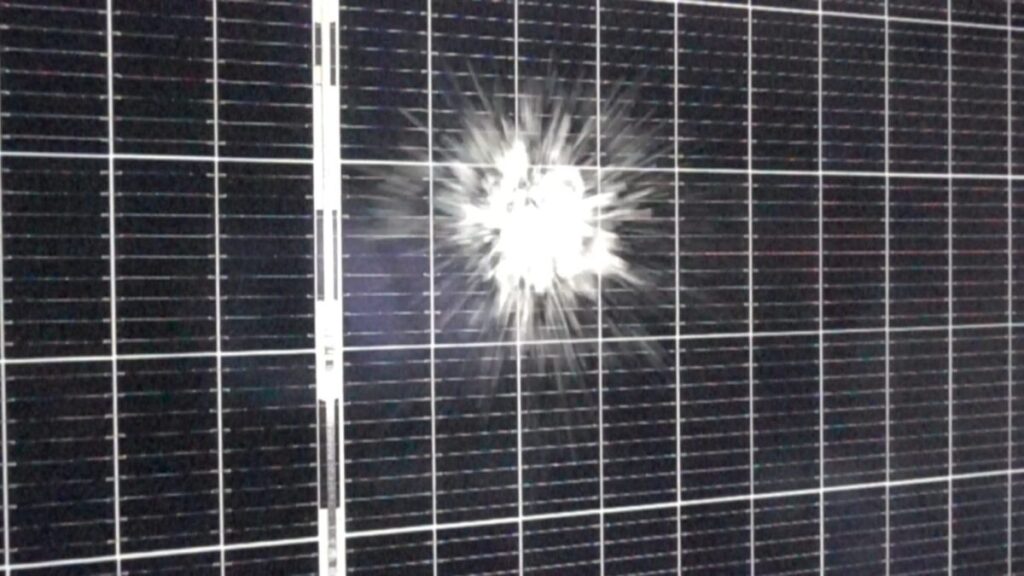The report from kWh Analytics, with input from several industry leaders, identified 14 risks to be aware of in the solar sector, including risks associated with extreme weather, such as hail, and operational risks.
A report from kWh Analytics, a climate insurer, has its 6e annual Solar Risk Assessment report, which provides a data-driven overview of the risks to solar assets. The report included contributions from solar industry leaders in technology, financing and insurance.
“To meet renewable energy deployment targets, the focus must be on smart growth – relying on data to inform decisions and using resiliency measures to protect assets,” said Jason Kaminsky, CEO of kWh Analytics.
The report identified 14 risks to be aware of in the solar industry, including those associated with extreme weather and operational risks. This year, for the first time, the risks of battery energy storage have been included. This news covers extreme weather risks, with subsequent articles discussing operational and storage-related risks.
Modeling assumptions underestimate losses from weather damage by 300% or more
Data from kWh Analytics has shown that risk modeling for weather damage is heavily overlooked. Particularly in major solar markets such as California, Texas and Arizona, actual losses due to weather events have been as much as 300% or more than what has been modeled by asset owners.
kWh Analytics said that since PV is a relatively new asset class, natural catastrophe models typically used to determine insurance premiums often rely on proxy structures to estimate losses. The company said that more accurate PV-specific modeling is needed, and that risk modeling should take into account differences in the technology used (such as trackers with hail protection).
The insurance company has developed new models that use location-specific risks, supported by National Renewable Energy Laboratory (NREL) data, significant loss data and satellite imagery to provide a more accurate risk assessment.
Modules perform well after significant cell damage
Kiwa PVEL reliability testing has shown that broken cells due to impacts such as hail are less catastrophic to solar panel performance than one would expect. No module tested by PVEL lost more than 3% production after undergoing a series of hail stresses.
The testing laboratory said that, rather than relying on expensive electroluminescent (EL) testing, it would recommend that asset owners conduct annual aerial thermal scans to identify cracked modules that have developed hotspots and are at risk of fire and need replacing become. The fire risk is most serious in the rare event that a module with a defective bypass diode has cracked cells.
Modules protected by hail storage, only 0.8% power loss
Waaree found that lab-tested solar panels that tilt to a stowed position to protect against direct hail impacts lose only 0.8% of their output due to being at a suboptimal angle during hail events. In turn, the modules could prevent damage altogether by storing them. The losses perform much better than the IEC standard of 5% losses due to entrainment.
Solar project insurance costs can be reduced by up to 50% by investing in resilient design and maintenance
Data from Alliant Power shows that assets in high-risk areas can reduce insurance costs by up to 50% by investing in resiliency measures such as selecting heat-tempered panels and trackers that enable hail storage.
“It pays to take time to differentiate your project and select highly qualified partners when it comes to risk and insurance,” said Alliant Insurance Services.
The number of natural disasters is increasing, with billions of dollars worth of weather events increasing from an average of 13 per year in the 2010s to an average of 22 per year in the 2020s, with $28 billion in weather damage expected to occur in 2023 alone. Alliance.
The chance of asset damage is 87% lower in a 75 degree hailstorm
Solar developer Longroad Energy shared a case study assessing different tilt angles and their impact on protecting modules against hail impacts. The report was based on data from RETC and tracker provider Nextracker.
It was found that a 50-degree storage led to an estimated 33% probability of module breakage, while a 60-degree storage had an 8% probability, and a 75-degree storage led to only a 1% risk of hail breakage.
The next report in this series will review the kWh Analytics assessment of solar operational risks.
To learn more about quality issues in utility-scale solar, register for a free webinar on Racking and Trackers: Factory Quality Issues and Design Considerations for Utility-Scale Solar Installations, June 11 at 11 a.m. ET. Register here.
This content is copyrighted and may not be reused. If you would like to collaborate with us and reuse some of our content, please contact: editors@pv-magazine.com.

